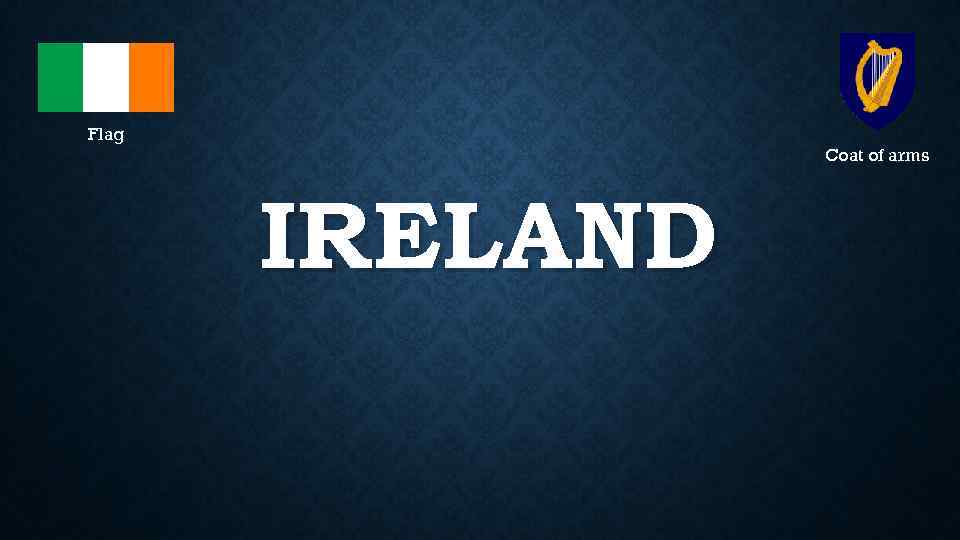 Flag Coat of arms IRELAND
Flag Coat of arms IRELAND
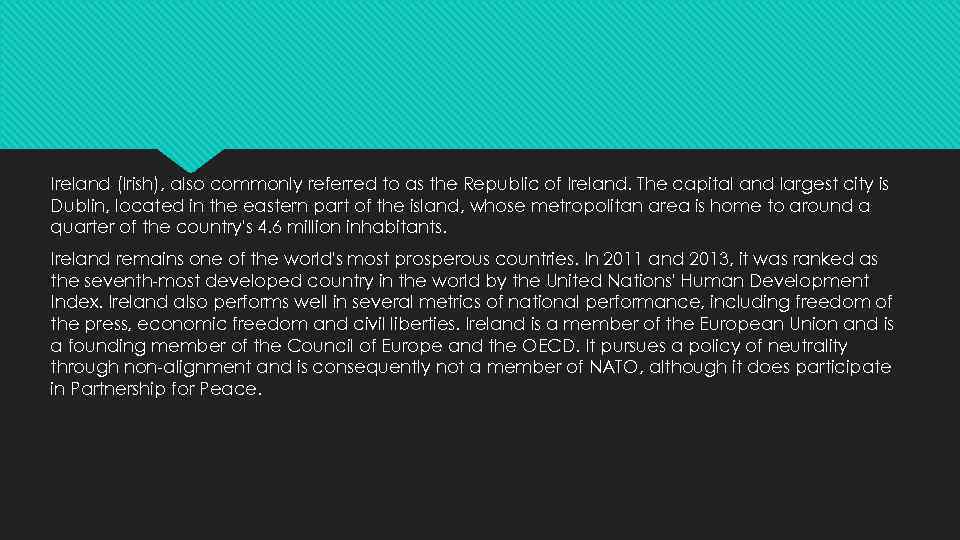 Ireland (Irish), also commonly referred to as the Republic of Ireland. The capital and largest city is Dublin, located in the eastern part of the island, whose metropolitan area is home to around a quarter of the country's 4. 6 million inhabitants. Ireland remains one of the world's most prosperous countries. In 2011 and 2013, it was ranked as the seventh-most developed country in the world by the United Nations' Human Development Index. Ireland also performs well in several metrics of national performance, including freedom of the press, economic freedom and civil liberties. Ireland is a member of the European Union and is a founding member of the Council of Europe and the OECD. It pursues a policy of neutrality through non-alignment and is consequently not a member of NATO, although it does participate in Partnership for Peace.
Ireland (Irish), also commonly referred to as the Republic of Ireland. The capital and largest city is Dublin, located in the eastern part of the island, whose metropolitan area is home to around a quarter of the country's 4. 6 million inhabitants. Ireland remains one of the world's most prosperous countries. In 2011 and 2013, it was ranked as the seventh-most developed country in the world by the United Nations' Human Development Index. Ireland also performs well in several metrics of national performance, including freedom of the press, economic freedom and civil liberties. Ireland is a member of the European Union and is a founding member of the Council of Europe and the OECD. It pursues a policy of neutrality through non-alignment and is consequently not a member of NATO, although it does participate in Partnership for Peace.
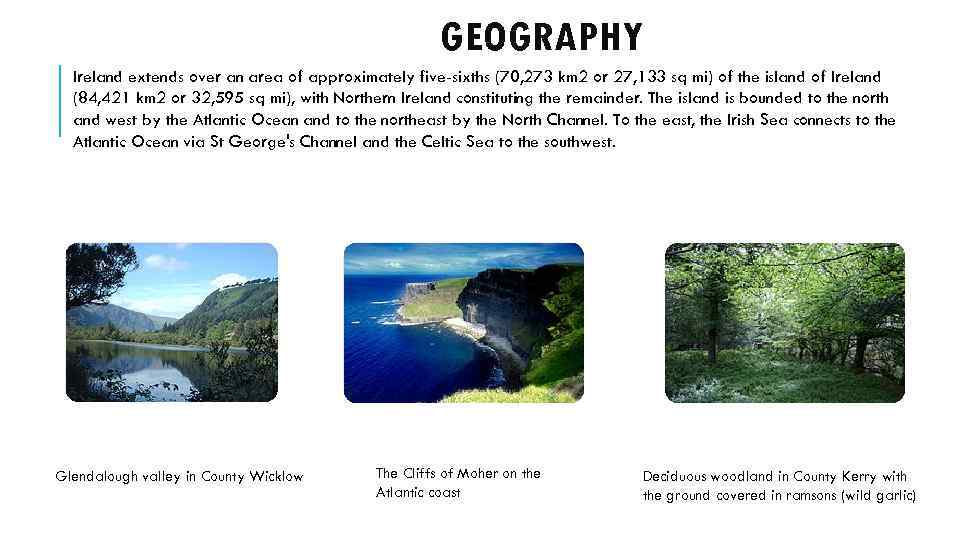 GEOGRAPHY Ireland extends over an area of approximately five-sixths (70, 273 km 2 or 27, 133 sq mi) of the island of Ireland (84, 421 km 2 or 32, 595 sq mi), with Northern Ireland constituting the remainder. The island is bounded to the north and west by the Atlantic Ocean and to the northeast by the North Channel. To the east, the Irish Sea connects to the Atlantic Ocean via St George's Channel and the Celtic Sea to the southwest. Glendalough valley in County Wicklow The Cliffs of Moher on the Atlantic coast Deciduous woodland in County Kerry with the ground covered in ramsons (wild garlic)
GEOGRAPHY Ireland extends over an area of approximately five-sixths (70, 273 km 2 or 27, 133 sq mi) of the island of Ireland (84, 421 km 2 or 32, 595 sq mi), with Northern Ireland constituting the remainder. The island is bounded to the north and west by the Atlantic Ocean and to the northeast by the North Channel. To the east, the Irish Sea connects to the Atlantic Ocean via St George's Channel and the Celtic Sea to the southwest. Glendalough valley in County Wicklow The Cliffs of Moher on the Atlantic coast Deciduous woodland in County Kerry with the ground covered in ramsons (wild garlic)
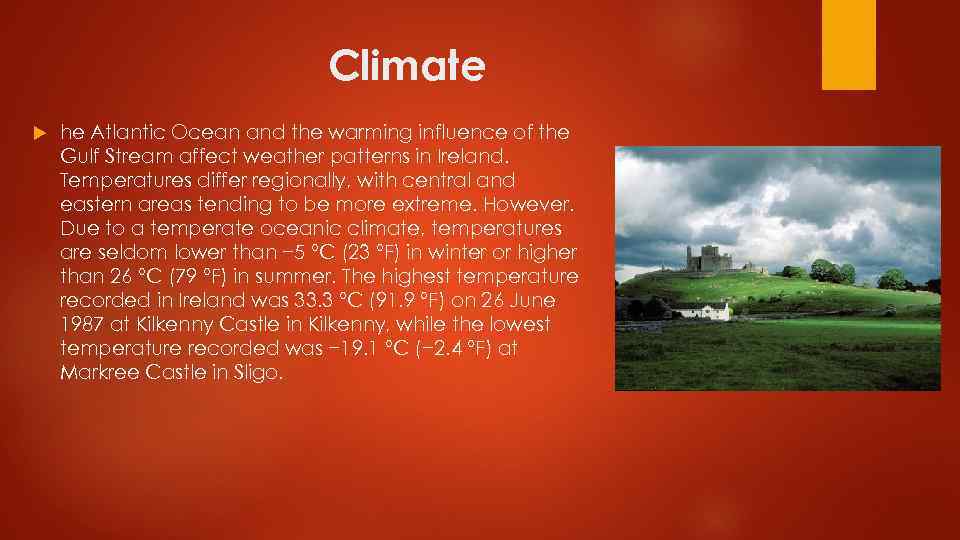 Climate he Atlantic Ocean and the warming influence of the Gulf Stream affect weather patterns in Ireland. Temperatures differ regionally, with central and eastern areas tending to be more extreme. However. Due to a temperate oceanic climate, temperatures are seldom lower than − 5 °C (23 °F) in winter or higher than 26 °C (79 °F) in summer. The highest temperature recorded in Ireland was 33. 3 °C (91. 9 °F) on 26 June 1987 at Kilkenny Castle in Kilkenny, while the lowest temperature recorded was − 19. 1 °C (− 2. 4 °F) at Markree Castle in Sligo.
Climate he Atlantic Ocean and the warming influence of the Gulf Stream affect weather patterns in Ireland. Temperatures differ regionally, with central and eastern areas tending to be more extreme. However. Due to a temperate oceanic climate, temperatures are seldom lower than − 5 °C (23 °F) in winter or higher than 26 °C (79 °F) in summer. The highest temperature recorded in Ireland was 33. 3 °C (91. 9 °F) on 26 June 1987 at Kilkenny Castle in Kilkenny, while the lowest temperature recorded was − 19. 1 °C (− 2. 4 °F) at Markree Castle in Sligo.
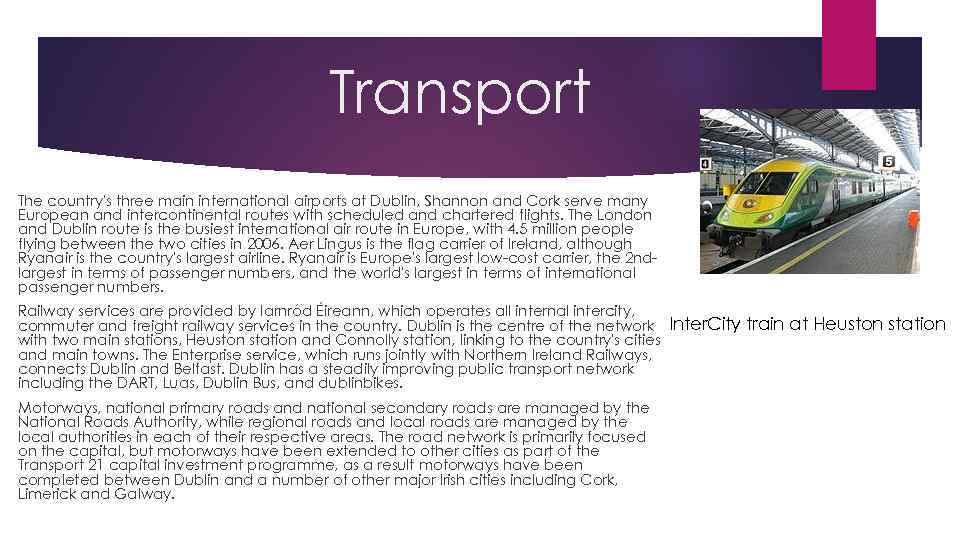 Transport The country's three main international airports at Dublin, Shannon and Cork serve many European and intercontinental routes with scheduled and chartered flights. The London and Dublin route is the busiest international air route in Europe, with 4. 5 million people flying between the two cities in 2006. Aer Lingus is the flag carrier of Ireland, although Ryanair is the country's largest airline. Ryanair is Europe's largest low-cost carrier, the 2 ndlargest in terms of passenger numbers, and the world's largest in terms of international passenger numbers. Railway services are provided by Iarnród Éireann, which operates all internal intercity, commuter and freight railway services in the country. Dublin is the centre of the network with two main stations, Heuston station and Connolly station, linking to the country's cities and main towns. The Enterprise service, which runs jointly with Northern Ireland Railways, connects Dublin and Belfast. Dublin has a steadily improving public transport network including the DART, Luas, Dublin Bus, and dublinbikes. Motorways, national primary roads and national secondary roads are managed by the National Roads Authority, while regional roads and local roads are managed by the local authorities in each of their respective areas. The road network is primarily focused on the capital, but motorways have been extended to other cities as part of the Transport 21 capital investment programme, as a result motorways have been completed between Dublin and a number of other major Irish cities including Cork, Limerick and Galway. Inter. City train at Heuston station
Transport The country's three main international airports at Dublin, Shannon and Cork serve many European and intercontinental routes with scheduled and chartered flights. The London and Dublin route is the busiest international air route in Europe, with 4. 5 million people flying between the two cities in 2006. Aer Lingus is the flag carrier of Ireland, although Ryanair is the country's largest airline. Ryanair is Europe's largest low-cost carrier, the 2 ndlargest in terms of passenger numbers, and the world's largest in terms of international passenger numbers. Railway services are provided by Iarnród Éireann, which operates all internal intercity, commuter and freight railway services in the country. Dublin is the centre of the network with two main stations, Heuston station and Connolly station, linking to the country's cities and main towns. The Enterprise service, which runs jointly with Northern Ireland Railways, connects Dublin and Belfast. Dublin has a steadily improving public transport network including the DART, Luas, Dublin Bus, and dublinbikes. Motorways, national primary roads and national secondary roads are managed by the National Roads Authority, while regional roads and local roads are managed by the local authorities in each of their respective areas. The road network is primarily focused on the capital, but motorways have been extended to other cities as part of the Transport 21 capital investment programme, as a result motorways have been completed between Dublin and a number of other major Irish cities including Cork, Limerick and Galway. Inter. City train at Heuston station
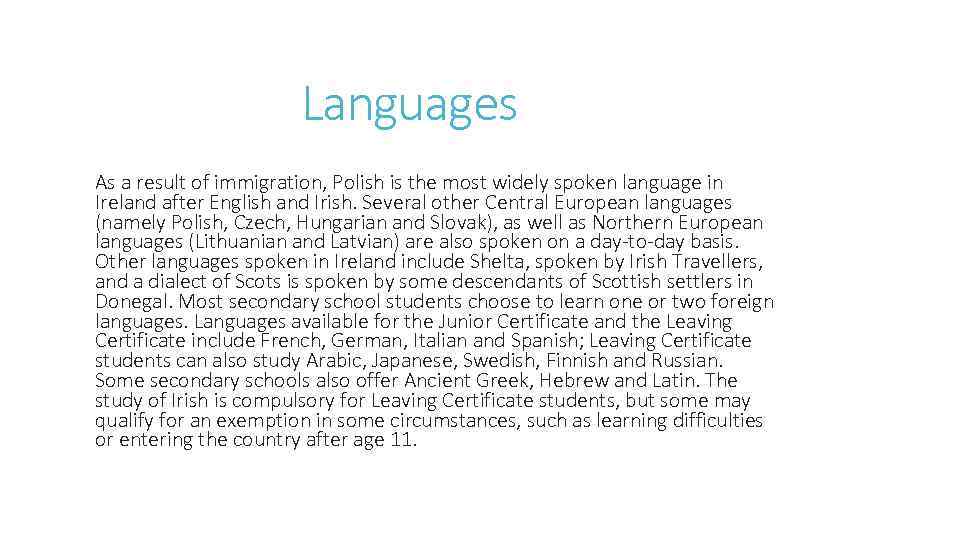 Languages As a result of immigration, Polish is the most widely spoken language in Ireland after English and Irish. Several other Central European languages (namely Polish, Czech, Hungarian and Slovak), as well as Northern European languages (Lithuanian and Latvian) are also spoken on a day-to-day basis. Other languages spoken in Ireland include Shelta, spoken by Irish Travellers, and a dialect of Scots is spoken by some descendants of Scottish settlers in Donegal. Most secondary school students choose to learn one or two foreign languages. Languages available for the Junior Certificate and the Leaving Certificate include French, German, Italian and Spanish; Leaving Certificate students can also study Arabic, Japanese, Swedish, Finnish and Russian. Some secondary schools also offer Ancient Greek, Hebrew and Latin. The study of Irish is compulsory for Leaving Certificate students, but some may qualify for an exemption in some circumstances, such as learning difficulties or entering the country after age 11.
Languages As a result of immigration, Polish is the most widely spoken language in Ireland after English and Irish. Several other Central European languages (namely Polish, Czech, Hungarian and Slovak), as well as Northern European languages (Lithuanian and Latvian) are also spoken on a day-to-day basis. Other languages spoken in Ireland include Shelta, spoken by Irish Travellers, and a dialect of Scots is spoken by some descendants of Scottish settlers in Donegal. Most secondary school students choose to learn one or two foreign languages. Languages available for the Junior Certificate and the Leaving Certificate include French, German, Italian and Spanish; Leaving Certificate students can also study Arabic, Japanese, Swedish, Finnish and Russian. Some secondary schools also offer Ancient Greek, Hebrew and Latin. The study of Irish is compulsory for Leaving Certificate students, but some may qualify for an exemption in some circumstances, such as learning difficulties or entering the country after age 11.
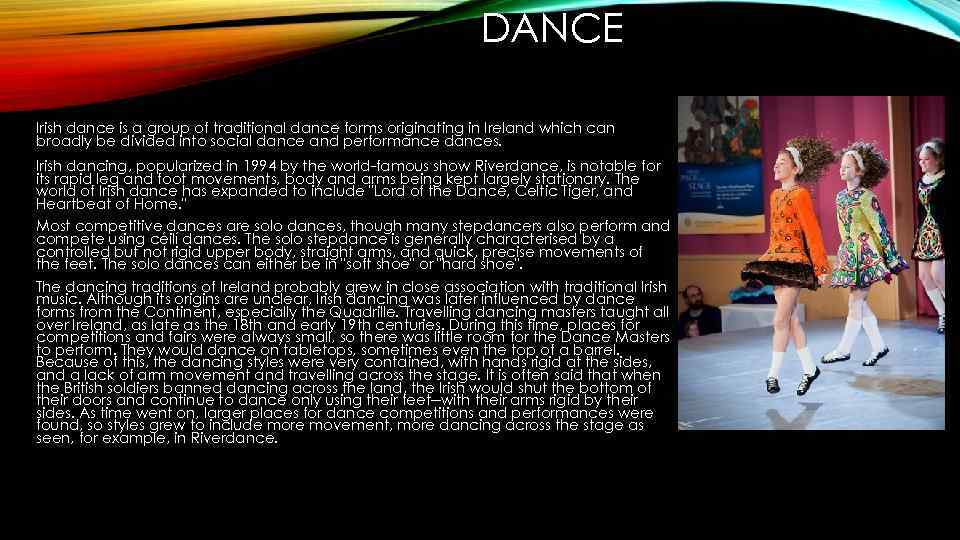 DANCE Irish dance is a group of traditional dance forms originating in Ireland which can broadly be divided into social dance and performance dances. Irish dancing, popularized in 1994 by the world-famous show Riverdance, is notable for its rapid leg and foot movements, body and arms being kept largely stationary. The world of Irish dance has expanded to include "Lord of the Dance, Celtic Tiger, and Heartbeat of Home. " Most competitive dances are solo dances, though many stepdancers also perform and compete using céilí dances. The solo stepdance is generally characterised by a controlled but not rigid upper body, straight arms, and quick, precise movements of the feet. The solo dances can either be in "soft shoe" or "hard shoe". The dancing traditions of Ireland probably grew in close association with traditional Irish music. Although its origins are unclear, Irish dancing was later influenced by dance forms from the Continent, especially the Quadrille. Travelling dancing masters taught all over Ireland, as late as the 18 th and early 19 th centuries. During this time, places for competitions and fairs were always small, so there was little room for the Dance Masters to perform. They would dance on tabletops, sometimes even the top of a barrel. Because of this, the dancing styles were very contained, with hands rigid at the sides, and a lack of arm movement and travelling across the stage. It is often said that when the British soldiers banned dancing across the land, the Irish would shut the bottom of their doors and continue to dance only using their feet--with their arms rigid by their sides. As time went on, larger places for dance competitions and performances were found, so styles grew to include more movement, more dancing across the stage as seen, for example, in Riverdance.
DANCE Irish dance is a group of traditional dance forms originating in Ireland which can broadly be divided into social dance and performance dances. Irish dancing, popularized in 1994 by the world-famous show Riverdance, is notable for its rapid leg and foot movements, body and arms being kept largely stationary. The world of Irish dance has expanded to include "Lord of the Dance, Celtic Tiger, and Heartbeat of Home. " Most competitive dances are solo dances, though many stepdancers also perform and compete using céilí dances. The solo stepdance is generally characterised by a controlled but not rigid upper body, straight arms, and quick, precise movements of the feet. The solo dances can either be in "soft shoe" or "hard shoe". The dancing traditions of Ireland probably grew in close association with traditional Irish music. Although its origins are unclear, Irish dancing was later influenced by dance forms from the Continent, especially the Quadrille. Travelling dancing masters taught all over Ireland, as late as the 18 th and early 19 th centuries. During this time, places for competitions and fairs were always small, so there was little room for the Dance Masters to perform. They would dance on tabletops, sometimes even the top of a barrel. Because of this, the dancing styles were very contained, with hands rigid at the sides, and a lack of arm movement and travelling across the stage. It is often said that when the British soldiers banned dancing across the land, the Irish would shut the bottom of their doors and continue to dance only using their feet--with their arms rigid by their sides. As time went on, larger places for dance competitions and performances were found, so styles grew to include more movement, more dancing across the stage as seen, for example, in Riverdance.
